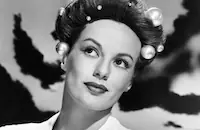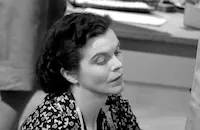Lady Gangster

Brief Synopsis
Cast & Crew
Florian Roberts
Faye Emerson
Julie Bishop
Frank Wilcox
Roland Drew
Jackie C. Gleason
Film Details
Technical Specs

Synopsis
Dot Burton, an aspiring actress, helps a gang of bank robbers to hold up a bank. The men escape but the police are suspicious of Dot's actions and arrest her. District Attorney Lewis Sinton asks Dot to turn state's evidence, but she continues to plead her innocence. Radio broadcaster Kenneth Phillips sees a newspaper article about Dot's case and broadcasts a statement lambasting the district attorney for arresting her while the real criminals go free. Sinton responds by suggesting that Phillips help in the investigation. He willingly agrees and begins by questioning Dot. Face to face, Phillips and Dot realize they know each other from childhood and Phillips arranges to have Dot released into his custody. Although Dot intends to go straight, when she overhears the other members of the gang plan to divide up her share of the stolen money, she hides the money from them. Dot intends to atone for her part in the crime by returning the money. Later, encouraged by Phillips to forget about the past, she starts to tell him of her involvement, but when he refuses to take her side, she confesses to Sinton and is sent to prison. There Dot is befriended by Myrtle Reed, but two other convicts, Lucy Fenton and Deaf Annie, ally against her. Soon Carey Wells, one of the bank robbers, dresses as a woman and visits Dot in prison. Deaf Annie reads his lips and tells Fenton that Dot knows where the stolen money is hidden. In the meantime, Myrtle has convinced Dot to let the guilt-ridden Phillips help her get paroled from prison. Fenton bides her time and when Dot comes up for parole, she suggests to the warden, Mrs. Stoner, that she offer to grant Dot parole in exchange for the money. Stoner makes the same suggestion to Phillips, who refuses. Fenton then convinces Dot that the suggestion was Phillips' idea, and Dot plots her revenge against him. She agrees to turn over the money if Phillips will pick it up alone and then gets word to the gang about the arrangement. Then, by accident, Dot learns that Phillips is innocent. She tries to stop him, and when Stoner refuses to allow her to phone him, she escapes in order to warn him of his danger. By the time Dot arrives, the gang has attacked Phillips, but she is able to lead him away. The gang holds Dot hostage, but eventually they are captured by the police. Phillips plans to marry Dot after she is paroled.

Director

Florian Roberts
Cast

Faye Emerson

Julie Bishop
Frank Wilcox
Roland Drew

Jackie C. Gleason
Ruth Ford
Virginia Brissac
Dorothy Vaughan

Dorothy Adams
Dewolf Hopper
Vera Lewis
Herbert Rawlinson
Peggy Diggins
Charles Wilson
Bill Phillips
Frank Mayo
Leah Baird
Ken Christy
Sol Gorss
Fred Kelsey
Daisy Bufford

Jack Mower
Joan Winfield
Crew

Film Details
Technical Specs

Articles
Lady Gangster -
By Violet LeVoit

Lady Gangster -
Quotes
Trivia
Notes
According to the CBCS, the film was cast by mid-April 1942. Production dates cannot be confirmed by Hollywood Reporter production charts, however. Florian Roberts was a pseudonym of Robert Florey, and according to modern sources, this film marked the only time he used a pseudonym. The play by Dorothy Mackaye and Carlton Miles was also the basis of the 1933 Warner Bros. film Ladies They Talk About, directed by Howard Bretherton and William Keighley and starring Barbara Stanwyck. Although the Variety review of the 1933 film stated that the play had been produced in Los Angeles with Mackaye in the lead, the SAB included in the file on the film in the AMPAS Library noted that the play had never been published or produced. According to the SAB, the play was retitled Gangstress. Although there is a copyright statement on the opening title card, the film is not listed in copyright records.















